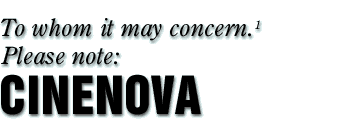|
 |
||
|
Mel Taylor uncovers some of the history of women's film and video making distribution, and discusses the continuing need for specialised promotion of women's work |
Next year will mark the twentieth anniversary of women's independent film and video distribution in Britain - a movement which grew out of the determined efforts of women filmmakers in the 1970s to uncover what was hidden from history: Women's Cinema.
Since then a great deal has changed, but an independent women's distribution network remains. Cinenova, based in the East End of London, is Britain's foremost distributor of film and videos by and about women - and the only distributor in Europe committed solely to promoting women's work.
Despite recent hard times Cinenova is approaching the new millennium with optimism, and it has good reasons. From 9 - 13 February 2000 it will host a major festival of new women's film, video and digital art at the Lux cinema. The festival will include screenings, performance, interactive events and discussions. It will also mark the launch of a new Cinenova web-site, and the cinematic release of a new feature film, Eileen is a Spy, by Minneapolis based writer/director Sayer Fry.
Cinenova aims to live up to its mission statement - to act as "a champion for the equality of women behind the camera, taking the diversity of women's voices to a global audience".
In the late 1940s a Russian emigré to the United States began making experimental 16mm films. Her name is Maya Deren, and she is widely recognised as the mother of the post-war avant-garde film movement. Maya Deren did not only make films, she wrote about them, organised touring screenings of work, and established the Creative Film Foundation to promote experimental film practice. Her influence, direct and indirect, upon the New American Cinema movement which emerged in the late 1950s - and consequently upon the British avant-garde movement of the 1960s -was curtailed by her early death in 1961.
The late 1960s: not only the sexual liberation of "free love" and Bottoms (Yoko Ono, 1966-7), but the reform of divorce laws in 1965 and the legalisation of abortion in 1967; changes which enabled women to take much greater control over their own lives. In addition, state funding and expansion of higher education was enabling significant numbers of women to enter universities and art colleges for the first time. Women's opportunities and expectations were being transformed, and in the early 1970s the Women's Liberation Movement emerged as a political and social force.
It is at this time that we begin to see the emergence of independent women filmmakers in Britain, such as Lis Rhodes, Annabel Nicolson, and Tina Keane. During the 1960s a number of women artists had been involved in time-based performance and light-works, often in collaboration with their (male) partners, but they have received little recognition. Annabel Nicolson was one of the first women to become involved in the LFMC, whilst a student at St. Martins, though she receives little mention in most accounts of the period.
The 1970s were radical times: the trade union movement was very powerful, and the miners brought down the Conservative government in 1974. More women were entering the workplace - and facing not glass ceilings, but steel doors blocking their progress. The women's movement took the campaign for equality into professional environments - and led the way for what became known as 'identity politics'. Not only feminism, but anti-racism and lesbian and gay rights were forcing their way onto the political agenda.
The high level of politicisation impacted upon and manifested itself within the independent film sector in two broad strands...
Mel Taylor
Thanks to: Gill Addison, Laura Hudson, Karen Powell, Felicity Sparrow, Bev Zalcock.
1. The title of a statement by Sandra Lahire, Mary Pat Leece and Lis Rhodes, published in Undercut, no. 19, Autumn 1990. The statement protested against the substantial cuts in funding of women's film/video and distribution groups in London made by the British Film Institute and Greater London Arts Association between 1985-1990.
Full article published in Filmwaves - Issue 8, Summer 1999. Subscribe now!
